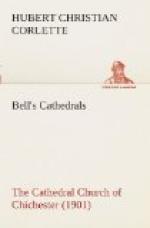The large rose window in the gable of the #East End# is of about the same date as the vaulting over the south transept, since they possess kindred details. In design it is a simple circle, with seven others within it of equal diameter. Portions of the coping of an earlier and lower pointed gable are bedded in the wall. Under the string beneath the rose window are three windows grouped as a triplet, with no label moulding. The centre light is higher than the others. Though each has been much repaired, the early thirteenth-century detail has been retained. The abaci of the capitals are square. The windows have no tracery, and are probably quite fifty years earlier in date than the large rose above them.
The exterior of the small chapel to the south has a square weathered angle buttress. On its south side is a window of the same date as the rest of the chapel, and like the triplet in the gable of the presbytery in character and date. Its east end has been altered since the chapel was finished. First a small rose window, recently renewed, of the same date and type as that in the presbytery gable, was inserted under the earlier narrow window close to the gable point; then the original east window was removed, and a larger one was put in, having three lights and a traceried head with cusped work of late fourteenth-or early fifteenth-century work. The sill of the old window was lowered to give more length. Most of the window now to be seen is the result of recent restoration. Parts of the old string-courses remain in the walling.
The south side of the #Lady-Chapel# beyond the chapel just described has four bays. In each of these is a large three-light window. The western and smallest one was probably first inserted. Then the two eastern ones were put in when the two east bays were added to the older lady-chapel. The other window appears the latest of the four; or else may it not be that before deciding to lengthen the lady-chapel, the builders first began only with the idea of inserting some new windows in the older walls? But before this scheme had been executed they concluded that they would add bodily to the chapel; and in order to allow the chapel to continue in use while this was being done, they built the extension first outside, then built up the connection with the original walls, and inserted their latest window. Two of the buttresses on this wall are flat. In this they are like those of the twelfth century; but their upper parts were rebuilt when the parapet was made. The others are later, and have more projection. On the north and south of the lady-chapel the wall is finished by a parapet. It is the same in detail and design as that on the south wall of the presbytery. So it is probable that Bishop Gilbert de S. Leophardo, when he lengthened the lady-chapel, caused other work to be done at the same time.




